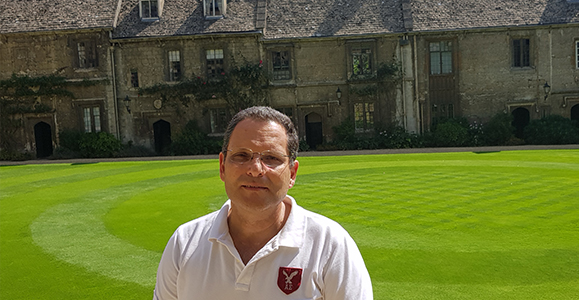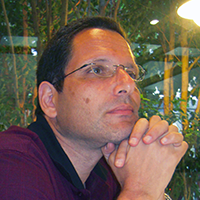
Teaching over Time and Space
After three decades of teaching in around a dozen universities, spanning three continents, and multiple disciplines, Chevening Alumnus Professor Raphael Cohen-Almagor reflects on the privileges and challenges of moulding young minds, and explores how teaching differs over time and space.
Learning curves
My journey as a teacher began at Tel Aviv University in 1985 when, as an MA Political Science student, I was offered my first teaching assistant role. Many of my students were significantly older than me, and they sometimes tested my knowledge and authority, but this taught me to always remain focused and professional. This first experience was, overall, a positive one which instilled in me the importance of preparation, a key lesson for any young teacher.
Upon completing my MA, I moved to the University of Oxford to pursue PhD studies. When my college tutor, the wonderful Wilfrid Knapp, asked me to lead some tutorials for his graduate students who were writing dissertations about the Middle East, I enthusiastically agreed. This was the least I could do for the man who was my mentor, stood by me throughout my studies, and was like a second father to me in England. Teaching in Oxford was very different to my experience in Israel. The one-on-one format resulted in more intense sessions with an advanced level of conversation and debate. I felt fortunate to be in the position to engage with such gifted students, and I felt enriched by their knowledge and our exchanges of ideas.
Breaking down disciplinary barriers
After completing my DPhil, I returned to Israel and began teaching at the Hebrew University Law Faculty. I recall walking down the corridor and being awed by the name tags on the doors. Each professor was a legend who had contributed a great deal to the history of jurisprudence in Israel, among them justices of the Supreme Court, attorney generals, and government ministers.
Teaching in Jerusalem was a privilege, as my courses in the fields of freedom of expression and medical ethics attracted excellent students who were interested in interdisciplinary learning, cutting across politics, law, philosophy, communications, and medicine. At the University of Haifa, I had a similarly enlightening experience, teaching in various departments and engaging with students from the social sciences, humanities and law, each of whom had a very distinct academic perspective and way of thinking. This experience strengthened my belief in the value of interdisciplinary teaching.

Cultural differences
My most challenging, but ultimately rewarding, year of teaching was at the University of California, Los Angeles (UCLA) as the Visiting Yitzhak-Rabin Fulbright Professor. At the School of Law, I taught a graduate seminar titled, ‘The right to live in dignity and the right to die in dignity’, which dealt with beginning of life issues, such as abortion, as well as end of life issues (euthanasia). Having previously taught similar courses in Israel, I was aware of the sensitivity of these issues, and the possibility that students in the class might have personal experiences that would influence their reasoning. I found that at UCLA, the arguments on abortion, in particular, were more one-sided than in Israel, demonstrating a significant cultural difference. This posed a challenge for me in creating a balanced debate whilst remaining sensitive to the personal nature of this discussion.
A few years later, I returned to teach in the United States, this time at the Advanced Studies Program, The Krieger School of Arts and Sciences, Johns Hopkins University, in Washington DC. I taught courses on freedom of expression and terrorism and felt privileged to teach such a talented group of students. Most of them had day jobs and were taking evening classes at Hopkins. They were mature, articulated and professional, knew what was required of them, and wished to excel. Teaching such a group of people was a very rewarding experience.
The differences in higher education in Israel and the USA speak to the wider cultural norms of the regions. In Israel, informality is celebrated and students call their lecturers by their first name, something I encourage; at UCLA and Hopkins students referred to me as ‘Professor’. In Israel, professorship is a rank, not only a profession, so in Los Angeles I suddenly found myself elevated to professorship (my rank was Doctor at that time)—at least in name. On the other hand, American students crossed certain barriers that would have been firm in Israel. For instance, I enjoyed being invited to a very pleasant dinner with a group of students in LA, while in Israel this kind of casual interaction would not have been possible.
Overall, I was very impressed with the American students. Of course, I also had very talented students in Israel, and the fact that most had completed compulsory army service before enrolling at university meant that they tended to be slightly more mature, and with greater life experience. However, I found that the UCLA and Hopkins students were better equipped to conduct research, and their written expression was, in one word, superb.
Challenges of teaching in the digital age
Over time, it is clear that the quality of students’ writing has suffered. In an age when many young people rely on social media for news and entertainment, academia has faced challenges. In 2008, I began teaching at the University of Hull and came to realise that many students today struggle to master grammar, articulate ideas, and apply careful analysis. To counter this, universities worldwide should devise creative solutions for examining students’ knowledge and abilities. For hundreds of years, students have been asked to write exams and submit essays. However, these forms of assessment seem to be ill-suited for the digital age. Universities should be open to new modes of assessment, including work submitted in the form of video clips, video games, webpage design, and other activities in which students could manifest their immense creativity and imagination.
Luckily, in each and every class I have many motivated students who wish to learn and my best students today are as strong as any I have taught in my previous posts. These engaged students, who are eager to learn, provide the fuel to continue my life’s mission as an educator.

